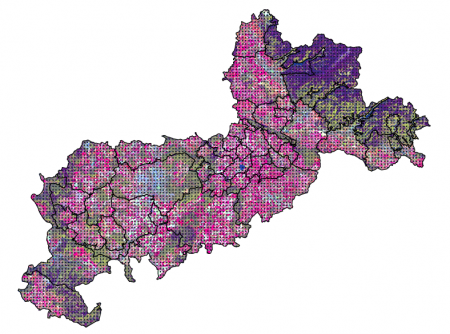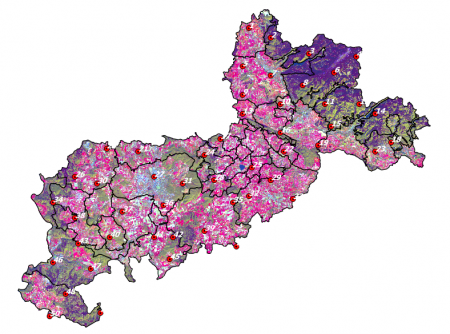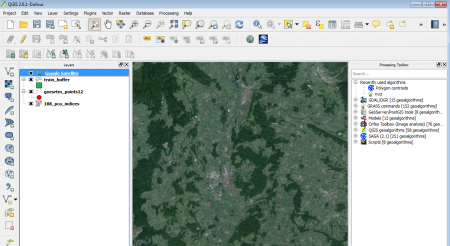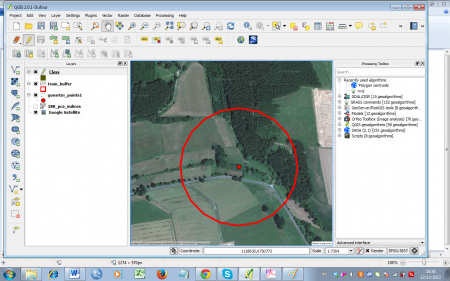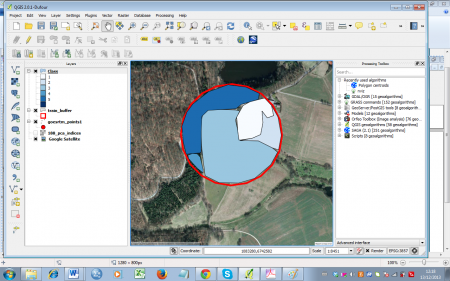Digitizing training and test areas
From AWF-Wiki
(Difference between revisions)
(→Figures) |
|||
| (9 intermediate revisions by 2 users not shown) | |||
| Line 1: | Line 1: | ||
| − | :'' | + | :''A very important step in supervised image classification is the collection of training data. This is done in the training phase during which information on the spectral reflectance, it's variability and range for all classes that will be distincted by the classification is obtained. At first, we have to define the categories according to the objectives of the remote sensing study and the users's need. The training phase depends on previous knowledge acquired by field work or other sources of information like high-resolution satellite images or aerial photos. Furthermore, the reference information should be as acquired at the time of image acquisition if possible. One approach to collect reference data is the manual image interpretation which is done by image interpretersen who digitizing, delineate and identify training areas. There are different opinions to collect reference areas. In general, digital image classifiers, accuracy and quality measures require statistical based (probability) sampling. Therefore we need to define a sampling- and plot design. For the accuracy assessment we need an additional independent reference data set. The sample size should be large enough to divide the reference data into training and test data.'' |
==Working steps== | ==Working steps== | ||
# Generating sample points | # Generating sample points | ||
| − | ## Load the raster | + | ## Load the the multiband raster file ''clip_SA2_2017-03-28_pca.tif'', which should be available in the [[Course data|course data]]. It contains the first 5 component as a result of a pricipal components analysis of a Sentinel-2 scene. |
| − | ## Open {{mitem|text=Vector --> Research tools --> regular points}}. | + | ## Open {{mitem|text=Vector --> Research tools --> regular points}}. Set the {{button|text=Input extent Layer}} to ''Use layer/canvas extent''. |
| − | ## | + | ## Enter the number 600 (meters) to {{button|text=Point spacing}}. |
| − | ## | + | ## Click {{button|text=Use point spacing}} on. |
| − | ## Enter | + | ## Enter an output shapefile name ''systematic_grid.shp'' and path by clicking {{button|text=Browse}}. |
| − | ## Confirm with {{button|text= | + | ## Confirm with {{button|text=Run}}. The new layer is added to the Layer Panel . |
| − | ## | + | ## clip the the layer ''systematic_grid.shp'' with the administrative boundary of the new municipality Göttingen ''Landkreis_GOE_neu_utm32.shp'' {{mitem|text=Vector --> Geoprocessing Tools --> Clip}} (figure '''A'''). |
# Buffering sample points | # Buffering sample points | ||
| − | ## Open {{mitem|text=Vector --> Geoprocessing tools --> | + | ## Load the vector file ''select_50points.shp which contains a spatially balanced sample of the systematic grid (s.a.). |
| − | ## Enter | + | ## Open {{mitem|text=Vector --> Geoprocessing tools --> Fixed distance buffer}}. Select the generated points shapefile as input layer. |
| − | ## Enter a file path and name, e.g. '' | + | ## Enter 100 (meter) as {{mitem|text=Distance}}. |
| − | # | + | ## Enter a file path and name, e.g. ''select_50points_buf'', confirm with {{button|text=OK}} and confirm (figure '''B'''). |
| − | ## Select {{mitem|text= | + | # As a reference layer you may add a google satellite layer as background |
| + | ## Select {{mitem|text=Web --> OpenLayers plugin --> Google Maps --> Google Satellite}} (figure '''C'''). | ||
##* If the Plugin doesn't exist in you [[QGIS]] installation, you'll first have to [[QGIS_plugin_administration|install]] it. | ##* If the Plugin doesn't exist in you [[QGIS]] installation, you'll first have to [[QGIS_plugin_administration|install]] it. | ||
# Create a new shapefile layer | # Create a new shapefile layer | ||
## Select {{mitem|text=Layer --> New --> New Shapefile Layer}}. | ## Select {{mitem|text=Layer --> New --> New Shapefile Layer}}. | ||
| − | ##* As layer type, select {{button|text=Polygon}}. Click the {{button|text=Specify SRS}} button and select WGS 84/ | + | ##* As layer type, select {{button|text=Polygon}}. Click the {{button|text=Specify SRS}} button and select WGS 84/ UTM 32N (EPSG:32632). |
##* To add an attibute: | ##* To add an attibute: | ||
##** For the attribute's name type ({{typed|text=Class}} into the {{button|text=Name}} field of the {{button|text=New attribute}} section. | ##** For the attribute's name type ({{typed|text=Class}} into the {{button|text=Name}} field of the {{button|text=New attribute}} section. | ||
| Line 32: | Line 33: | ||
==Figures== | ==Figures== | ||
{| class="wikitable" style="border: 0pt" | {| class="wikitable" style="border: 0pt" | ||
| − | |style="border: 0pt" | [[file: | + | |style="border: 0pt" | [[file:systematic_grid.png|thumb|450px|'''Figure A:''' Map ''systematic_grid'' clipped with boundary of municipality Göttingen]] |
| − | |style="border: 0pt" | [[file: | + | |style="border: 0pt" | [[file:selected_points_buffered.png|thumb|450px|'''Figure B:''' Selected sample points buffered with radius = 100m]] |
|- | |- | ||
|style="border: 0pt" | [[file:RemSens_Exercise06_03.png|thumb|450px|'''Figure C:''' Google satellite layer loaded via the ''Open layers'' plugin]] | |style="border: 0pt" | [[file:RemSens_Exercise06_03.png|thumb|450px|'''Figure C:''' Google satellite layer loaded via the ''Open layers'' plugin]] | ||
Latest revision as of 09:00, 24 April 2017
- A very important step in supervised image classification is the collection of training data. This is done in the training phase during which information on the spectral reflectance, it's variability and range for all classes that will be distincted by the classification is obtained. At first, we have to define the categories according to the objectives of the remote sensing study and the users's need. The training phase depends on previous knowledge acquired by field work or other sources of information like high-resolution satellite images or aerial photos. Furthermore, the reference information should be as acquired at the time of image acquisition if possible. One approach to collect reference data is the manual image interpretation which is done by image interpretersen who digitizing, delineate and identify training areas. There are different opinions to collect reference areas. In general, digital image classifiers, accuracy and quality measures require statistical based (probability) sampling. Therefore we need to define a sampling- and plot design. For the accuracy assessment we need an additional independent reference data set. The sample size should be large enough to divide the reference data into training and test data.
[edit] Working steps
- Generating sample points
- Load the the multiband raster file clip_SA2_2017-03-28_pca.tif, which should be available in the course data. It contains the first 5 component as a result of a pricipal components analysis of a Sentinel-2 scene.
- Open Vector --> Research tools --> regular points. Set the Input extent Layer to Use layer/canvas extent.
- Enter the number 600 (meters) to Point spacing.
- Click Use point spacing on.
- Enter an output shapefile name systematic_grid.shp and path by clicking Browse.
- Confirm with Run. The new layer is added to the Layer Panel .
- clip the the layer systematic_grid.shp with the administrative boundary of the new municipality Göttingen Landkreis_GOE_neu_utm32.shp Vector --> Geoprocessing Tools --> Clip (figure A).
- Buffering sample points
- Load the vector file select_50points.shp which contains a spatially balanced sample of the systematic grid (s.a.).
- Open Vector --> Geoprocessing tools --> Fixed distance buffer. Select the generated points shapefile as input layer.
- Enter 100 (meter) as Distance.
- Enter a file path and name, e.g. select_50points_buf, confirm with OK and confirm (figure B).
- As a reference layer you may add a google satellite layer as background
- Create a new shapefile layer
- Select Layer --> New --> New Shapefile Layer.
- As layer type, select Polygon. Click the Specify SRS button and select WGS 84/ UTM 32N (EPSG:32632).
- To add an attibute:
- For the attribute's name type (Class into the Name field of the New attribute section.
- Select Whole number as data type.
- Confirm with Add to attributes list.
- Confirm with OK and enter the path and name (e.g. Training) in the following menu.
- Select Layer --> New --> New Shapefile Layer.
- Digitizing areas
- Open the file digitizing_classes.pdf from the course data for a reference of landscape classes.
- Select the new shapefile in the TOC. Start the edit mode by clicking the Toggle editing button
 .
.
- Zoom in on a sample point (figure D). Click Add feature
 to start digitizing. Draw polygons according to the landscape classes. Simply click the desired point on the canvas to start. After selecting a second point, the third point will construct a triangle and each additional point will add another triangle to the geometry. Finish the geometry by right-clicking and entering the attributes in the appearing window (just use an increasing number for the ID). Take your time to get used to this way of digitizing -- you can always delete the last polygon by simply clicking Cancel in the attributes dialogue, or by selecting it
to start digitizing. Draw polygons according to the landscape classes. Simply click the desired point on the canvas to start. After selecting a second point, the third point will construct a triangle and each additional point will add another triangle to the geometry. Finish the geometry by right-clicking and entering the attributes in the appearing window (just use an increasing number for the ID). Take your time to get used to this way of digitizing -- you can always delete the last polygon by simply clicking Cancel in the attributes dialogue, or by selecting it  and deleting with the Delete selected
and deleting with the Delete selected  button. An example of a finished sample point can be seen in figure E.
button. An example of a finished sample point can be seen in figure E.
